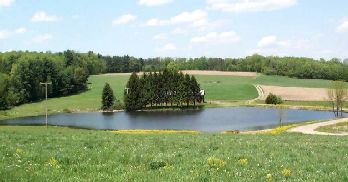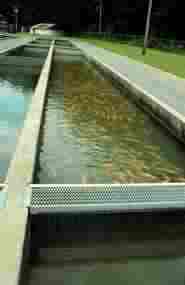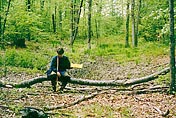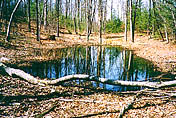The following questions were submitted via e-mail and answered over a period of years by staff in the Department of Natural Resources at Cornell University, and answers to some common questions are provided below. Currently, we are not in a position to respond to further questions.
Question contents:
|
III. Water Quality
|
|
I was wondering if you could help me find a good source of information on building a farm pond. |
See sources of information on pond construction listed on our web site. One of the best sources of information is: "Ponds - Planning, Design, Construction." The USDA Natural
Resources Conservation Service (NRCS)- Agriculture Handbook 590. It contains detailed information on design surveys, site selection, drainage area, pond layouts, soil analysis and spillway
construction. Contact your county NRCS office to obtain a copy Is a pond of irregular shape (land piers, etc.) preferable over a standard circle or oval? |
What permits are necessary to construct a pond in New York?
Permit requirements for fish management in New York ponds are described on the New York State Department of Environmental Conservation web site.
I have a pond approximately 100 x 100 ft. that will need to be dredged and enlarged. Could you direct me to some contractors that have some experience digging out ponds?
County Soil and Water Conservation District offices often have information about contractors within a local area.
Where can I purchase fish for stocking my pond?
In early spring, many New York county Soil and Water Conservation District offices sell fish for stocking. In addition, the New York State Department of Environmental Conservation maintains a list of hatcheries with permits to rear or sell selected fish species
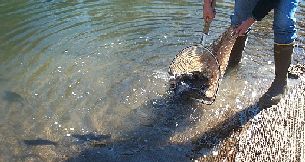 My only caution about autumn stocking of trout in a relatively new pond is that if you have any problems with low oxygen levels during winter, you might lose your fish. If the pond is fairly deep and has a source of groundwater, this certainly wouldn't be of any concern. |
|
All things being equal (coldwater pond available or a warm water pond available)
which fishery type (trout vs. bass) is: easier to manage?
Warmwater
Least expensive to manage?
Warmwater
Easier to establish?
No advantage to either
Least expensive to establish?
No advantage to either
Question: Why are my fish dying?
The fish in my pond are dying. The pond is 30 by 60 feet across and about 10 feet deep and connected to a 2 acre swamp with lots of hemlock. It has a sandy bottom and the water is tea-colored. After construction in March, I stocked the pond with 12 inch bullhead. About two weeks after stocking the pond I started to notice about 10 dead bullhead each day that were floating on the pond with no apparent wounds, and I have also seen a small number of dead sunfish.
Response:
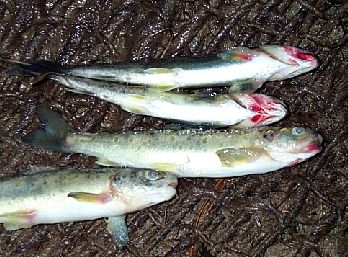 Dead landlocked Atlantic salmon, gills flared |
Whenever you observe a fish kill, it's important to ask the following questions: 1). What is the source of water for the pond? Is there a source of organic material that could deplete oxygen in the pond's water? 2). Is the pond choked with vegetation? 3). Were the gills of the dead fish flared? 4). Did you find mostly large dead fish or small dead fish, or were all sizes of fish found dead? |
One possibility is that fish are dying in this pond as a result of decomposition or decaying organic material that depleted oxygen levels in the pond water, and this could have occurred as a result of the pond's recent construction. It's also possible that organic material is entering the pond from the nearby swamp, contributing to oxygen depletion. When fish mortality is caused by a toxic substance, small fish die before larger ones of the same species. However, the opposite is true -- i.e. larger fish die first -- when dissolved oxygen depletion occurs within a pond.
Bullheads are extremely hardy to low oxygen, and the fact that you observed a few dead fish each day indicates that there is some sort of low-level chronic mortality agent in the pond, such as the production of hydrogen sulfide gas from the decay of material that was inundated when the pond was formed. If that's the case, then this problem should go away within a few months. Spawning stress also often weakens fish and makes them susceptible to disease, but the early onset of this problem after stocking makes it likely that the fish didn't have time to begin spawning. Give the pond some time to get settled, then restock it in the fall or next spring.
VHS Disease
Question: I recently had a large fish kill in my pond and have been hearing a lot about VHS disease in the media, so wondered whether this could be affecting fish in my pond?
As of now, there's no firm answer as to whether VHS (a viral disease formally known as "Viral Hemorrhagic Septicemia") can be responsible for the fish kill that you observed. The New York State Department of Environmental Conservation is leading efforts to track the spread of VHS through fish within New York waters, and this agency maintains a VHS web site that provides updated information on this subject. This web site recommends that people who find a large number of dead or dying fish (usually 100 or more) should contact the nearest DEC regional office and ask for the Bureau of Fisheries. Questions about VHS and potential DEC actions to prevent its spread can be e-mailed to fwfish@gw.dec.state.ny.us or by calling 518-402-8896.
The state VHS expert in the Cornell Vet School provided some additional information that should be useful to pond owners concerned about VHS as the cause of fish dieoffs.
1) First, VHS is a fish virus and, to date, is not considered to be capable of being transmitted from one waterbody to another by sources other than movement of fish from one waterbody to another.
2) The key question for a pond owner concerned about VHS having been transmitted into their pond is whether fish have been stocked into the pond recently. If not, VHS is an unlikely cause of a recently observed fish dieoff.
3) Regarding geese or other birds as a source of VHS, in one study researchers found that VHS virus could be recovered from herons that regurgitated infected fish 90 minutes after a meal. Beyond that, it is generally accepted that this virus does not survive well in a acid environment, therefore VHS is not expected to survive passage through a bird's digestive tract (i.e. due to too much acid exposure in the stomach). Additionally, the fact that geese are not a fish-eating bird suggests that geese are an unlikely source of the virus.
I am interested in finding out about fish farming. Can you direct me to some information on how to get started and where to market the final product? I currently own an abandoned farm in Delaware county with good springs for ponds. Before establishing ponds, though, I would like to research the requirements are for raising trout or other game and food fish. I may also consider raising fish in indoor aquatic tanks. However, I need to do more research about the "how to's."
The most comprehensive Internet source of information regarding aquaculture ishttp://www.aquanic.org/. This is the first place for someone to begin looking for information on the subject.
Question: Removing Fish and Starting Over
What's the best way to eliminate all the fish from my small pond so that I can start all over by re-stocking it? The bullheads and stunted bass are out of control.
The best option is to drain the pond completely, which is often possible for diked ponds. If a pond can't be drained, then the next best option would be to pump the water out of the pond, which often isn't as difficult as it may sound since large pumps are available for rent. Short of draining the pond, the only way to eliminate all fish from the pond would be with rotenone (or another fish poison). Within New York State, you would need a Department of Environmental Conservation permit and would have to hire a licensed applicator to do the work.
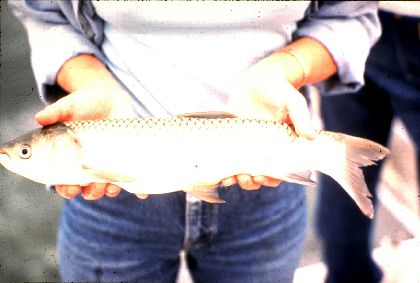 Grass carp (image: Dr. Michael Masser, Texas A&M University) |
How many grass carp should I stock in my lake? Will this hurt the gamefish? Grass carp stocking densities are still a matter of debate. A recent report (February 2001) produced by New York DEC fisheries biologist Leslie Surprenant summarized 13 years of experience with grass carp in Walton Lake, Orange County. The data showed that grass carp controlled Eurasian milfoil after preferentially consuming more palatable vegetation, however, the level of control was unpredictable. In Walton Lake, grass carp only resulted in moderate control of milfoil at a stocking density of 15 carp per vegetated acre of lake, whereas in other regional waters grass carp nearly eradicated rooted aquatic vegetation at this stocking density. Region 3 of the New York DEC therefore currently recommends a stocking density of 10 to 12 fish per vegetated acre in larger waters where macrophytes perform a significant ecological function. The Walton Lake experience also showed a decline in largemouth bass abundance, which is likely due to the complete absence of vegetated habitat, which was eliminated by grass carp. |
Question: Spring fed -- cold enough for trout?
When we bought our house in 1998, neighbors told us that we had a spring fed pond. Does that mean that the water is cold enough for trout?
The general public uses the term "spring fed pond" more frequently than do professional hydrogeologists, who are experts in groundwater movement. Almost all New York ponds have some groundwater input, but a more important consideration is the length of time during which water entering a pond has been underground. For example, summer rain that percolates into surface soil layers -- say the top ten to twenty feet --then enters a pond through subsurface layers is not likely to be very cold. Deeper aquifers represent what we usually refer to as groundwater. These sources of sub-surface water remain underground long enough to take on the mean average air temperature, which results in cold water. To determine if your pond has water cold enough for trout, you will have to measure its temperature, or at least identify cold sources of water during warm mid-summer periods.
What can I do to to prevent low oxygen problems in my pond?
During the winter oxygen depletion can be prevented by:
(1) Keeping ice free of snow throughout the winter. For ponds 1/2 acre or smaller, keep the entire pond surface clear; for larger ponds, clear 1/2 acre for each surface acre of pond.
(2) Cutting 15-20 holes (at least 2-3 inches diameter) through ice evenly distributed on a 1/4 acre pond, and pumping water from the pond and allowing the water to drain back into the pond through the ice. Pump water for 3-4 hours, 2-3 times a month during the winter.
(3) Keeping approximately 1/3 of the surface area of your pond free of ice throughout the winter for oxygen exchange. Use compressed air bubbles or aerators to facilitate the exchange.
If low oxygen problems occur, aerate with:
(1) An irrigation pump drawing water from mid-depth and spraying it back over the pond.
(2) Commercial aerator pump that sprays water into the air.
How can I clear my pond of muddy water?
It is important to reduce sources of suspended clay particles that can be caused by wave action on bare shorelines. Grass can be planted to help ease bank erosion and large rocks or sandbags can be placed to divert wave action. Heavy rains may also temporarily cause muddy water conditions.
Applications of chemicals -- generally called flocculants and coagulants -- can be used to clear muddy ponds. Alum (aluminum sulfate) applied at a rate of 150-300 pounds per acre (15 to 25 mg/L) has proven to be an effective treatment. However, alum may lower the water pH, and in soft water (less than 20 mg calcium carbonate) alum should be used in combination with limestone (at a 2:1 ratio of alum:calcium carbonate) to buffer large-scale and sudden changes in acidity. Gypsum (calcium sulfate) and fine agricultural limestone (calcium carbonate) applied at a rate of 1,000-2,000 pounds per surface acre have also been used to clarify ponds, though these chemicals are often not as effective as alum in clearing muddy ponds. All of these chemicals are widely available at farm supply stores. Hydrated lime -- also called quick lime (calcium oxide) -- should NOT be used because it can readily kill fish and other organisms.
For further information, go to: "Clearing Muddy Pond Waters" (by Virginia Cooperative Extension)
What's an ideal pH range for my pond?
Ideally pond water pH should be between 6.5 and 9.0 (a pH of 7.0 is neutral, <7 is acidic, >7 is basic). The majority of NY fishponds have a suitable pH.
You can raise the pH of your pond by applying ground agricultural limestone uniformly to surface water (1,000 lbs per surface acre). The pH of your pond cannot be determined by soil pH kits. Various
water pH kits are sold, but reliability and price vary greatly. Outdated reagents are a common cause for inaccurate reading, so check the expiration date on kits if available.
Back to top
I read today that tilapia eat algae. One major concern for pond owners is how to manage filamentous algae. Finding the nutrient sources that lead to the algae can often be very difficult. I was wondering about the feasibility of annually stocking tilapia to reduce algae levels. Are tilapia available locally and would the fish grow enough, without supplemental feeding, to be harvested in one season?
Unfortunately, tilapia won't be very useful to reduce filamentous algae in New York ponds. Yes, tilapia eat algae, and probably would eventually eat some of the filamentous algae that occur in small New York ponds. But tilapia are likely to prefer eating almost anything else before eating these filamentous algae, which often contain slightly toxic compounds (which boosts their resistance to "grazing" by fish) and offer very little nutrition. This leads to poor fish growth and generally poor fish condition.
At the moment I am also uncertain if it would even be legal to stock tilapia in New York waters, and suspect that this would be illegal. In general, tilapia are unlikely to survive outdoors through a typical New York winter, but in the southern US, tilapia have become established in public waters to the detriment of favored fish like largemouth bass and native sunfish. A trend to warmer winters might change the ability of tilapia to survive in New York. Nevertheless, tilapia have a US track record as a nuisance invader. Fishery managers now generally follow a policy that no longer permits the stocking of nonnative fish at locations where these fish are not currently present. This is a sensible and long-overdue change in attitude by managers.
Regarding whether tilapia would grow large enough to be harvested in one season, I doubt it. So overall, you can see that this is not a likely solution to manage filamentous algae. I wish I could be more encouraging.
What's an ideal pH range for my pond?
Ideally pond water pH should be between 6.5 and 9.0 (a pH of 7.0 is neutral, <7 is acidic, >7 is basic). The majority of NY fishponds have a suitable pH.
You can raise the pH of your pond by applying ground agricultural limestone uniformly to surface water (1,000 lbs per surface acre). The pH of your pond cannot be determined by soil pH kits. Various
water pH kits are sold, but reliability and price vary greatly. Outdated reagents are a common cause for inaccurate reading, so check the expiration date on kits if available.
Back to top
Question: Controlling nutrients from other sources
I have a pond with an overgrowth of duckweed. After some research, I discovered that the neighbors horses in the field up hill from my pond could have led to high levels of nutrients running into my pond from their waste. The horses are now gone. My questions is How long before the run off from that field will no longer effect the nutrients in my pond?
It's impossible to say for certain how long these nutrients will remain because pond sediments can retain accumulated nutrients for many years, during which time they will continue to stimulate plant growth. If you're certain that available sources of nutrient inputs to your pond are no longer present, you might consider having the pond sediments dredged to remove accumulated stores of nutrients. That's a fairly dramatic solution, but the only other alternative is to wait and see how long it takes the available nutrients to become depleted.
Question: Pond vegetation management
I have a question relating to water hemlock growing near the shore of an Adirondack lake. Any ideas on how to to environmentally eliminate or reduce the growth of this species?
Unfortunately, I cannot offer specific advice on the control of aquatic vegetation. For more information on vegetation management, see Management of Pond Plants. You may also wish to consult additional sources such as a Penn State bulletin: "Pond Management and Aquatic Plant Control," which is available from their distribution office: (814) 865-6713. The USDA/ARS Poisonous Plant Research Laboratory has a website that offers some guidance on the control of water hemlock (Cicuta douglasii).
If I want to use chemicals to control pond vegetation, how do I proceed?
In New York state, the application of algaecides and herbicides to control vegetation in ponds requires a NYSDEC pesticide permit. These chemicals should be administered only by a licensed professional. Using pesticides in pond environments located within a regulated wetland, also requires a special wetlands permit. An updated listing of New York Aquatic Pesticide Application Firms is maintained by the NYDEC.
Is it advisable to have one or two large trees (if so, what type) around a pond or should it be avoided?
Tree roots can destroy a dike, so trees should never be planted near a diked pond. For ponds without a dike, shoreline trees are appropriate. As trees grow older their roots will create a path for water to follow through the dike, ultimately reducing the integrity of the structure. A dike holding back a large volume of water is always subject to a great amount of stress, so any loss of cohesion within the dike makes it more susceptible to failure. If you look at failing roads throughout New York State you can see many situations where the flow of water underneath the road has led to a large failure. Simply, it's not a good idea to poke holes in a structure that requires mechanical integrity, and that's exactly what trees and shrubs are doing when growing upon a dike.
Question: Organic weed control
I have a pond (depth 14-15 ft) that was renovated three years ago. It is now full of poly wogs and has many plants growing in it, grasses and cattails in particular. I seeded a conservation mix around the pond to prevent erosion and mow it. I grow organic crops in the vicinity of the pond and I am looking for organic methods of weed control for the pond plant growth.
Organic weed control is a holy grail that remains elusive. Essentially, the alternatives are:
1) to remove the vegetation manually
2) to reduce available nutrients to the extent that plant cannot thrive
3) increase the pond depth at locations where emergent grasses and cattails are growing
4) accept the fact that this pond is going to sustain grasses, cattails and other plants.
Question: Controlling duckweed
How do I get rid of duckweed?
Duckweed is usually most abundant in ponds or areas of ponds with little surface agitation by wind or waves. Therefore, any type of aeration device will help get rid of duckweed. Some pond owners have had success with simply removing duckweed from the surface by raking it off the surface with a type of rake that is sold as a swimming pool cleaning device. Another alternative is to stock grass carp into a pond, which can be successful at consuming duckweed, but their presence can also lead to substantial algae blooms. Finally, there are several herbicides that are used for controlling duckweed.
Question: How do I attract waterfowl to my pond?
I have built a small pond in the middle of a wooded area. It is rather murky. How can I attract waterfowl to the pond? Is there anything special that ducks eat (duckweed?) that I could plant ?
More information regarding the size (surface area & depth) and location (surrounded by extensive woods, bordered by woods on one side only, etc.) of your pond would help me better answer your question, but I'll provide some general guidelines. If the woodland pond is less than one-quarter acre in surface area and less than 2 feet deep, it is unlikely to attract waterfowl. I should also point out that few waterfowl in the northeastern US are likely to use a woodland pond, with the exception of wood ducks (which are beautiful birds and prefer woodlands due to their habit of nesting in tree cavities) and black ducks (less likely to prefer a woodland pond). Wood ducks can be encouraged to use a woodland pond by placing a nest box in a tree adjacent to the pond. I cannot provide a place to find information about constructing and locating a nest box, though you could try the Cornell Laboratory of Ornithology web site as a place to start. Wood ducks would eat duckweed, though I doubt you would have to do anything to encourage its growth, other than possibly "seed" the pond with a few plants obtained from many public ponds.
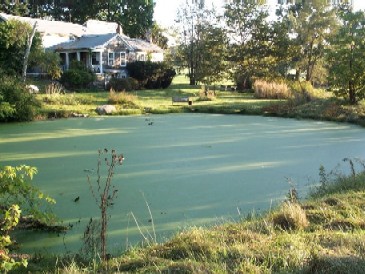
Pond covered in duckweed
|
We recently purchased a 9 acre lot with a large spring fed pond. Muskrats have burrowed holes in several locations around the pond and seem to be draining
the water out of the pond. There are cattails around and I have read that muskrats love to eat them. So far I have not been able to find out if the real problem is the muskrats, or the banks around
the pond, or maybe the trees (6-8 ft from the water) are drinking up the water. Do you have any suggestions?
|
|
Muskrats can cause problems in ponds with earthen dams by weakening the dam structure with burrowing activity. Muskrats are particularly attracted to ponds that have extensive cattail beds, and their feeding activity can result in the elimination of these cattails. Muskrat burrows can produce extensive leaks in a pond dike.
To protect the integrity of the pond dam, I would suggest having a trapper catch and remove the muskrats this winter while the pelts are useable. You can ask for a list of local fur trappers from you nearest DEC regional office. Fur trappers will often catch the animals for free; nuisance wildlife trappers will charge a fee.
It sounds like the pond is excellent muskrat habitat, so new animals will likely return at some point in the future. You can trap again at a later date. If you need to draw the pond down at some point, you could also cover the areas where burrowing in most severe with large rocks to protect the shoreline. This is expensive, but may provide the only long-term relief.
Question: Leeches
I recently purchased a piece of property that has a spring fed pond that is about 1/2 acre in size and has a maximum depth of 14 feet. While swimming in the pond, I have noticed some leeches attached to my feet. Is there anything that can be done to rid the pond of these leeches without harming other wildlife like fish and birds that use the pond?
There are no easy solutions to remove leeches from your pond. Many different types of leeches thrive in New York ponds, and small ponds often provide a suitable environment. Draining the pond in late fall allows the mud bottom of the pond to freeze, which can help eliminate leeches.
Another method suggested by the Schoharie County Soil and Water (Conservation District News) is the 'Leech trap.' They recommend the following:
Start with a coffee can with a plastic lid
Poke holes in the sides of the can with a nail. Holes should be 1/8 to 1/4 inch in size. The nail holes should leave a sharp burr on the inside of the can (approximately 50 holes).
Put about 1/4 cup of raw meat in the can (ground beef, liver, chicken or turkey giblets are recommended).
Put the lid on the can and submerge it completely in your pond. A rock placed on top of the can will prevent it from falling over and will help prevent snapping turtles from tampering with it.
Check the trap a couple of times a week and remove the leeches. Keep the trap in the pond until the leech numbers decrease, or you no longer catch any leeches in the trap.
There are a few good Internet resources available if you would like to learn more about leeches. The Department of Natural Resources, Water and Land Resources division of King's County, Washington offers an informative web page on leeches and the Australian Museum online offers a more detailed description of leech biology.
I was bass fishing a small farm pond and caught several largemouth bass. When I cleaned the fish, I found a parasite embedded in the meat of the fish. At first I thought it was a fatty cyst or something of that nature. It was yellow or creamy in color, round, and about the size of a BB. I didn't think much of it until I found so many in all of the fish I caught. I removed one of them and was holding it in my hand studying it when it unfolded into some sort of worm and started crawling around.
This was likely a common parasite called "yellow grub." A description and photo can be found at a Michigan DNR web site
Wild fish normally carry a variety of parasites, and usually show no negative effects unless the infection is extremely heavy. Largemouth bass are commonly infected with a bass tapeworm that lives in the intestine of fish. Fortunately, this organism does not infect humans. Two other parasites frequently observed by anglers are the yellow grub, and the black grub or black spot parasite. The yellow grub is the larval stage of a trematode worm which forms small whitish or yellowish cysts in the flesh and near or just beneath the skin. Black grub parasites are also the encysted larvae of trematode worms, and appear as a small black spot about the size of a small pinhead, in or just beneath the skin.
Both of these parasites have a complex life cycle involving snails, fish, and fish-eating birds such as herons or kingfishers. The adult worms live in the mouth and throat of fish -eating birds and eggs are shed into the water as birds feed along the pond shoreline. The free-swimming larvae infect snails after the eggs hatch, then later, advanced larvae emerge from the snail and penetrate the skin of a fish. When the fish is eaten by a bird, the cycle is completed.
Although these parasites are rather unappealing, they will not infect humans and are killed when fish are thoroughly cooked. No chemical treatments are available to eliminate these parasites from ponds. However, since snails are an essential part of these parasites' life cycle, the presence of fish (or crayfish) that eat snails can reduce the abundance of such parasites. On the other hand, the presence of abundant snails is often a sign that parasites are likely to be present in a water body.
Question: Dredging vernal pools
I'm wondering if dredging silt (about 1 foot) from vernal pools is detrimental to the organisms living in or around the pool.
|
Vernal ponds are increasingly being recognized as a critical habitat for a variety of organisms including several amphibian and invertebrate species. A nice guide to these organisms was recently published: "A Field Guide to the Animals of Vernal Pools" by Leo P. Kenney and Matthew R. Burne (published by the Mass. Division of Fisheries and Wildlife). The ephemeral nature of the vernal pools prevents the establishment of fish predators and thereby is critical to maintaining these organisms' populations. For several reasons, dredging the ponds is deleterious to these unusual communities: a) many of the organisms have adapted to the periodic drawdowns by storing eggs or other reproductive propagules in the sediments of the ponds, so removal of those sediments impacts their successful regeneration (-- then the eventual rise in water level is the cue for germination or metamorphosis), b) dredging the ponds will either permanently drain all the water out of the ponds and so remove the conditions appropriate to these organisms or conversely, access the groundwater table, forming a more permanent pond system that can be easily invaded by fish that would prey on the organisms. Either way, the ephemeral hydrologic conditions of these systems will be impacted. Legally, these vernal ponds do not have any protection as wetlands in most states and so are highly vulnerable to draining and dredging. |
|
We have a home in Schoharie County, with a half-acre pond. The pond seems healthy, with frogs, salamanders, and minnows. It is fed by a stream (when it rains), as well as by underground springs. It drains through a large pipe, eventually reaching a nearby creek. This summer, with the drought, the pond is down about three feet, and it has not been overflowing. For two years, I have been swimming in it with no problems. Last month, one or two days after swimming, I discovered many bites on my body, which itched badly. After three days they were healed. I swam again a few days later, and again, after a day or so, many welts appeared on my body. What could be causing them?
We do not claim to have the medical expertise to determine the cause of your problem, and suggest contacting a dermatologist or other physician to evaluate your condition. However, we are familiar with a parasite that cycles from ducks to freshwater snails that produces a condition referred to as "Swimmer's Itch," and this parasite produces symptoms similar to those you have described. These waterborne parasites burrow into swimmers and die, thereby producing allergic reactions that last for several days and take the form of itchy bites. A thorough summary of swimmer's itch, including some suggestions for prevention or treatment, can be found on the web at: The Swimmer's Itch Home Page
